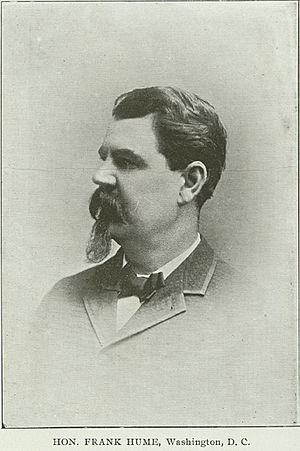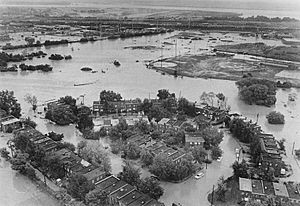Hume Springs, Virginia facts for kids
The Hume Springs neighborhood is a cool place in Alexandria, Virginia. It has about 175 red-brick row houses. These homes were built in 1942. You can find Hume Springs on four streets: East Reed Avenue, Dale Street, Edison Street, and Mark Drive.
The neighborhood is next to Four Mile Run Park. This park is huge, covering over 48 acres! It's the biggest suburban park in the Washington D.C. area. To the north of Hume Springs, you'll find the Four Mile Run stream and Arlington, Virginia. To the east is the Cora Kelly Recreation Center. Just a little further is Route 1 and Potomac Yard, where a new Metro station is located.
To the west of Hume Springs is Arlandria. This area is also called Chirliagua. Many people from El Salvador have lived here since the 1980s. Arlandria is home to the Birchmere concert hall and the Alexandria Aces baseball team. You can also find the Four Mile Run Farmers and Artisans Market and St. Rita's Church, which was built in 1949. South of Hume Springs is the historic Del Ray neighborhood. It has many restaurants, outdoor seating, yearly festivals, and a popular farmer's market.
The homes in Hume Springs were first built during World War II. They helped house the many new government workers. These workers were moving to the area for jobs. Many lived in temporary homes along Route 1. Some worked at the Alexandria Torpedo Factory. Others were employees of the United States Department of War. These workers would later move into The Pentagon, which was being built nearby. The Pentagon is less than 3 miles north of Hume Springs.
Hume Springs: A Look at Its Past
Hume Springs gets its name from Frank Hume (1803–1906). He once owned the land where the neighborhood now stands. Frank Hume was a confederate soldier and a spy during the American Civil War. After the war, he became a very successful grocer and liquor seller in Washington D.C. He was also known as a philanthropist, meaning he gave a lot of money to good causes.
Mr. Hume owned a large property called the Warwick Estate. There was a famous spring on this land. It had a big stone gazebo. Wealthy guests from Washington D.C. often visited the spring in the summer. This famous spring was located near where old Mount Vernon Avenue met Reed Avenue. Sadly, it was later destroyed to make way for roads and new buildings.
The Warwick Estate was famous for its Fourth of July parties. These celebrations included fireworks and cannon fire. Guests could watch them over the Potomac River. Frank Hume also gave his name to the historic Hume School. This school was built in 1891. It is on Arlington Ridge and is the oldest school building in Arlington County.
The land where Hume Springs is today was chosen by George Washington in 1791. It was part of the original diamond shape of the District of Columbia. In 1846, the land that is now Alexandria and Arlington (including Hume Springs) was given back to Virginia. This happened for economic reasons and because of concerns about slavery. This event was called retrocession.
Twenty-four years later, in 1870, the City of Alexandria became separate from the county (now called Arlington County). The Hume Springs land stayed with the county.
In 1908, the Town of Potomac was created. This town included the marshy land of Hume Springs. It was part of what is now Arlington County. It wasn't until 1920 that the county changed its name from Alexandria to Arlington. Then, in 1930, the City of Alexandria took over the Town of Potomac. This finally brought Hume Springs under the control of the City of Alexandria, where it remains today.
Wetlands: Nature's Influence on Hume Springs
Hume Springs is very close to the large Four Mile Run Park. It is also near an 11-acre tidal freshwater wetland. This wetland is part of the watershed for the nearby Potomac River and the Chesapeake Bay. A watershed is an area of land where all the water drains into a common body of water.
In the 1970s, about two acres of the wetland were filled in. This happened when the stream channel was dug deeper. People hoped this would stop the area from flooding. The Hume Springs neighborhood itself was built on parts of a tidal marsh that had been filled in.
Because the Four Mile Run watershed is very developed, neighborhoods and businesses near the stream often flooded. This started in the 1940s. To stop this flooding, Alexandria and Arlington worked together in the 1970s. They partnered with the US Army Corps of Engineers (USACE). Their goal was to build a flood-control channel in the lower part of Four Mile Run. This channel, or levee corridor, was built during the 1970s and early 1980s.
Today, Alexandria and Arlington are working together again. They want to restore the stream's natural banks and plants. This is called "greening" the area. They are also adding new paths and crossings. These will help people around the future Potomac Yard metro station. This project is part of the Joint Four Mile Run Restoration Master Plan. It is a big plan, costing $261 million, to improve the stream area. In 2015 and 2016, officials celebrated the completion of a $1.8 million project. This project restored a 2-acre tidal wetland. Here, the water levels change with the daily tides along Four Mile Run.
Hume Springs in the 2010s
In 2015, Hume Springs got a lot of attention from the news. This was because the Hume Springs Playground Park was completely redone. This project was a partnership between a non-profit group called RunningBrooke and the City of Alexandria.
The Hume Springs neighborhood has also seen changes in its residents. More young white professionals are moving in. They are looking for more affordable homes closer to Old Town Alexandria, downtown D.C., Crystal City, and The Pentagon. Also, older residents are moving out, which creates more homes for sale. In 2010, about 50% of residents were Latino (mostly from El Salvador). About 20% were African American, and 30% were White or other groups.





